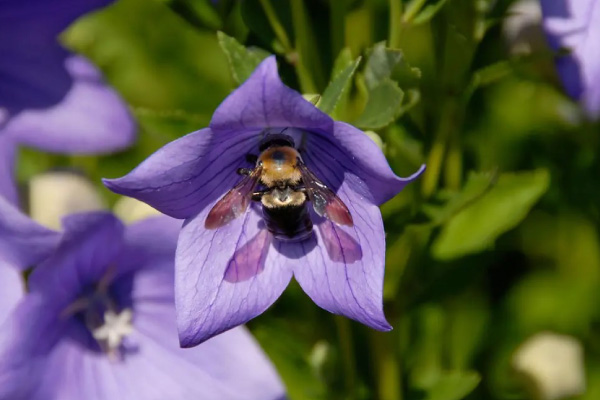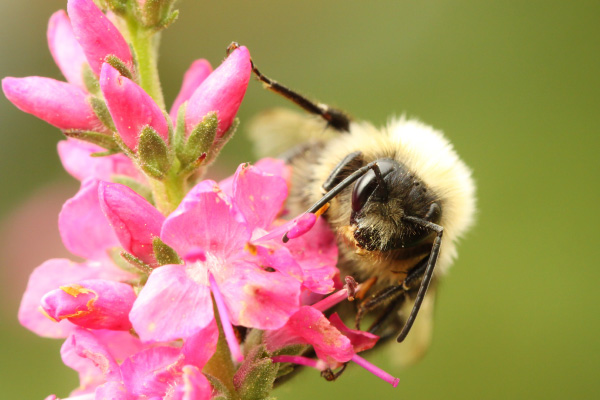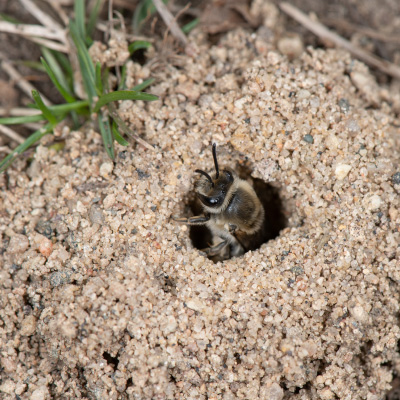Bee-lieve it or not... bees are considered the most important pollinator in the world. Lucky for us, here in Colorado we have the fifth most bee diversity in the United States! You can find 946 native bee species in Colorado. Native bees are important because they are the species that naturally occur in an area, and are the basis of that ecosystem by pollinating native plants that would not be able to reproduce as effectively without them. There are species of bee that have been accidentally brought to new places by humans, but the most well-known nonnative bee, the European honey bee, is used intentionally for agriculture. Both native and non-native bees are important pollinators, but since native bees have co-evolved with the flowering plants in the area, they are better adapted to pollinate these flowers. All of the bees we find around here are extremely beneficial to the local ecosystem, but today we are going to focus on a few bumbling bees in particular. Bumble Bee on a mountain harebell flower.
Bumble Bee on a mountain harebell flower.
Some very important native bees we have in the Vail area are the Bumble Bees, Bumbus sp.. This name comes from the Greek word bombos, which means “a buzzing sound.” Bumble bees are the most effective pollinators in alpine ecosystems due to their ability to create their own heat and to fly over long distances. There are 24 different species of bumble bees in Colorado with unique pollination styles that are necessary for certain native plants to reproduce, such as many plants in the legume (Fabaceae) and aster (Asteraceae) families. This special pollination style is called buzz pollination. Bumble bees will land on a flower and then buzz their wings at a specific vibration that shakes pollen out of the flower's anthers onto their body.
Not only are bumble bees necessary for buzz pollination, there are some alpine bumble bees that specialize in pollinating alpine tube flowers. Tubular flowers have fused petals that create a structure called the corolla, which is where the bees go to eat pollen and nectar. Two of these bumble bees, Bombus balteatus and B. sylvicola, have long tongues to reach into the corolla of alpine flowers, such as Indian paintbrush and alpine skypilot. These bees grew their long tongues through a co-evolutionary relationship with alpine flowers that have a tube-like structure. These long-tongued bumblebees are seeing changes as our climate changes. We have seen a 70% decrease in alpine flower density since 1970 because of drier conditions in the alpine life zone. Within 40-50 years, scientists have already found that these bumble bees' tongues are getting shorter to become more generalized pollinators, an example of rapid evolution. A recent study has shown that these bumble bee tongues have already decreased in length by almost 25%. The adaptation of a long tongue, which was once evolutionarily successful, is being lost as the bees need to become more generalized to access different flowers.
The bumble bees are shown to already be adaptive to the changing alpine climate, but the flowers might not survive the changes now that they are losing their specialized pollinators. This extraordinary case for rapid evolution shows us climate change is already making big changes in nature.
 This fall you might notice that you see bumble bees less often. Once temperatures start dropping, most of the colony starts dying off. Only the queen bee will survive through winter and start her new colony in springtime. Bumble bee queens hibernate underground during the wintertime, unlike honey bees. You can help ensure their survival next year by planting native plants this fall and avoiding the use of pesticides and herbicides in your yard.
This fall you might notice that you see bumble bees less often. Once temperatures start dropping, most of the colony starts dying off. Only the queen bee will survive through winter and start her new colony in springtime. Bumble bee queens hibernate underground during the wintertime, unlike honey bees. You can help ensure their survival next year by planting native plants this fall and avoiding the use of pesticides and herbicides in your yard.
Sources:
https://www.sciencemag.org/news/2015/09/warming-world-has-shrunk-bee-tongues
https://science.sciencemag.org/content/349/6255/1541
http://agbio.agsci.colostate.edu/wp-content/uploads/sites/115/2013/03/Bumble-Bees.pdf
https://extension.colostate.edu/topic-areas/insects/attracting-native-bees-landscape-5-615/
https://ranchlands.com/2021/03/22/bees/?utm_source=rss&utm_medium=rss&utm_campaign=bees
https://www.morningagclips.com/where-do-bees-go-in-the-winter/
https://www.honeybeesuite.com/bumble-bees-hibernate-honey-bees-do-not/
https://climatechangeresponses.biomedcentral.com/articles/10.1186/s40665-014-0001-5
https://www.highcountrygardens.com/plant-finder/bee-friendly-plants/providing-habitat-for-bumblebees
Liv Irelan is a Naturalist at Walking Mountains Science Center and bee lover, you can find her trying to hunt down bees on local mountain biking and hiking trails around the valley.









